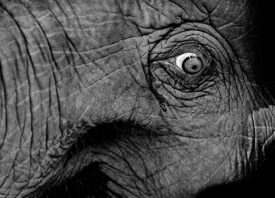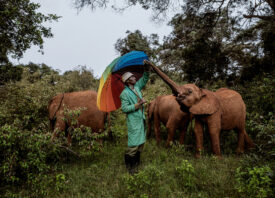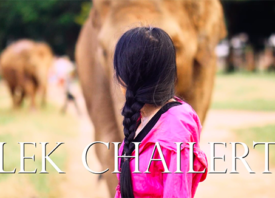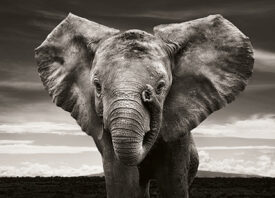Search this site
During the Pandemic, Elephants Got a Respite from Abuse. It Should Stay That Way.


“In 2011, I was in a village in Thailand near the Cambodian border, and we visited a camp where there was a large bull elephant chained under a tree,” the photojournalist Adam Oswell tells me. “He had terrible injuries and scarring on his head from constant beatings from a bullhook and was very stressed. I later found out he was a wild bull recently caught in a Khao Ang Rue Nai Wildlife Sanctuary in Thailand. He was a massive animal, and they had absolutely broken him with pain and fear-based training. I’m not sure what became of him.”
For about a decade now, Oswell has been covering the elephant tourism industry. Another photograph of his, this one of a crowd surrounding an elephant performing at an underwater zoo in Thailand, recently won the Natural History Museum’s 2021 Wildlife Photographer of the Year Award for the Photojournalism category. Along with the industry itself, the photographer has followed the pressure it’s placed on wild elephant populations in Thailand.

As demand for elephant attractions rose, elephants–like the wild bull Oswell encountered near the Cambodian border–were taken from the wild after being separated from their herds. Their mothers were often killed defending them. From there, these elephants are fed into the tourist trade, with both the animals and their keepers, known as mahouts, leased by camps for tourists. For a long time, many of these businesses profited from the exploitation of both the elephants and the mahouts, the photographer explains.

When the pandemic hit and tourism collapsed, the mahouts were forced to return home to their villages, bringing the elephants with them. For the elephants, this transition marked a significant departure from life in the camps. “Indigenous cultures have strong cultural traditions based around elephants, and in these communities, the elephants are generally well respected and treated as part of the family,” the photojournalist explains. “Most owners develop strong lifelong relationships with their elephants and have a strong sense of responsibility and compassion.”
In the beginning, the transition was difficult. “When the elephants first returned from the tourist camps, there was a bit of human-elephant conflict,” Oswell says. “Of course, you can’t just bring 200 elephants into an area and not have them impact the local community and the local farms. Some elephants died of starvation and malnutrition because they couldn’t get enough food, and others have raided crops and been shot in retaliation or been poisoned by pesticides that are used on cash crops.“
But to avoid this kind of conflict, communities have adapted, with some villages opting to release the elephants into community forests. “These community-managed lands serve as a space where the elephants can graze naturally on the forest vegetation,” Oswell explains.

In early 2022, Oswell, who is a contributor at We Animals Media, embarked on a journey to document Thailand’s elephants amid the Covid pandemic that halted tourism. During this time, he visited several communities and rescue projects caring for these elephants. The most successful, he says, are the ones that released the elephants into community forests. “These are the projects that really made me realize there is a viable long-term solution for domestic elephants,” he explains.
“The elephants are far better off in the forest; they can get a better diet through a mix of different types of natural food sources, which leads to better health outcomes, rather than being fed the same thing all the time. And they’re less stressed because they can explore their natural behaviors: for example, they can play in rivers and creeks.
“Also, the owners are much better able to care for them in the forests. I noticed young elephants learning to be in their natural forest habitat, learning about different food sources. That is something they could never do in a fully domestic situation.”


Even as income from the tourist trade dried up, many of these mahouts also took time to reflect–and reimagine a more sustainable future. “A lot of elephant owners have realized that the business model was unsustainable and exploitative and are now developing their own more ethical and sustainable business models,” Oswell continues. “Covid has changed the industry completely.
“If the elephants are properly managed and kept away from crops, people do appreciate having them around because they bring income into the community in the form of tourists staying in the villages in homestays and paying for activities to learn about indigenous culture. At a time when a lot of these communities are suffering from the economic downturn due to the pandemic, it is empowering for them to develop their own independent businesses, while at the same time improving their elephants’ quality of life.”
Those changes could have a ripple effect beyond these communities as well. “The elephant camps that operate under the old business model and still offer elephant riding are now a lot more aware that the majority of tourists don’t want to see those practices,” the photographer says. “And they have been so affected by the pandemic that they are now reassessing how they do things.”
Of course, it’s up to tourists to decide what practices they support. “The best way to effect change is to support ethical and sustainable models and avoid camps that are exploitive and don’t have good business models or the appropriate facilities to care for the elephants,” Oswell stresses. “If tourists just do some simple research before they visit an elephant camp and choose more ethical and sustainable places, then more pressure will be applied on elephant camp owners to change and meet that demand.”
In ten years of covering the elephant tourism industry and the cruelty inflicted at camps like that one on the Cambodian border, Oswell has experienced moments of depression and despair. He’s had to push himself to continue, drawing strength in other people working on behalf of wildlife conservation and animal welfare. This time, he found hope in the community forests, the elephants themselves, and the people who dared to do things differently.
“I met an ethnic Karen man recently who had lived with a female elephant the same age all his life,” the photojournalist tells me. “He worked and cared for her, and they were inseparable; their love for each other was obvious. They both had similar health problems: sore legs, an aching back, fading eyesight, and bad hearing–all the things we usually suffer from when we get old. I remember watching them walk home together through the village in the evenings. They were very close.”




Until that day arrives, GTAEF and its partner hotels provide work, such as tourist experiences and therapy sessions for children, for those elephants that can handle it, while offering a safe, healthy environment for those incapable of working. GTAEF also helps elephants, mahouts and families in other ways, providing access to English lessons and education for mahouts and their children. In addition, GTAEF collaborates with the government and non-government organizations on large projects while seeking to ensure that its actions are positive and that when it assists one elephant, it does not have an adverse impact on others. 2021 © Adam Oswell / We Animals Media



